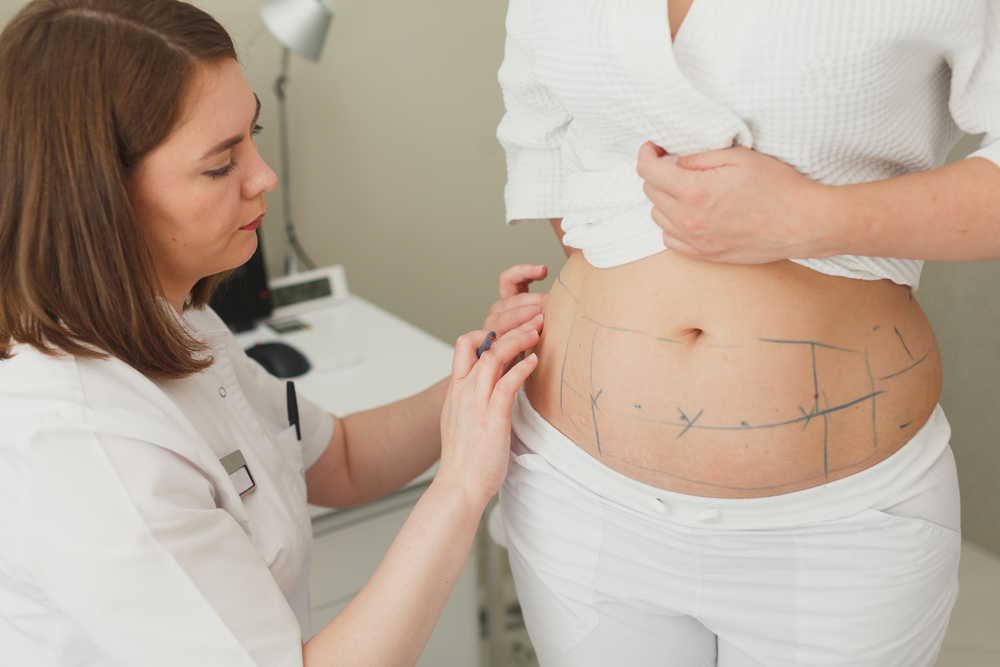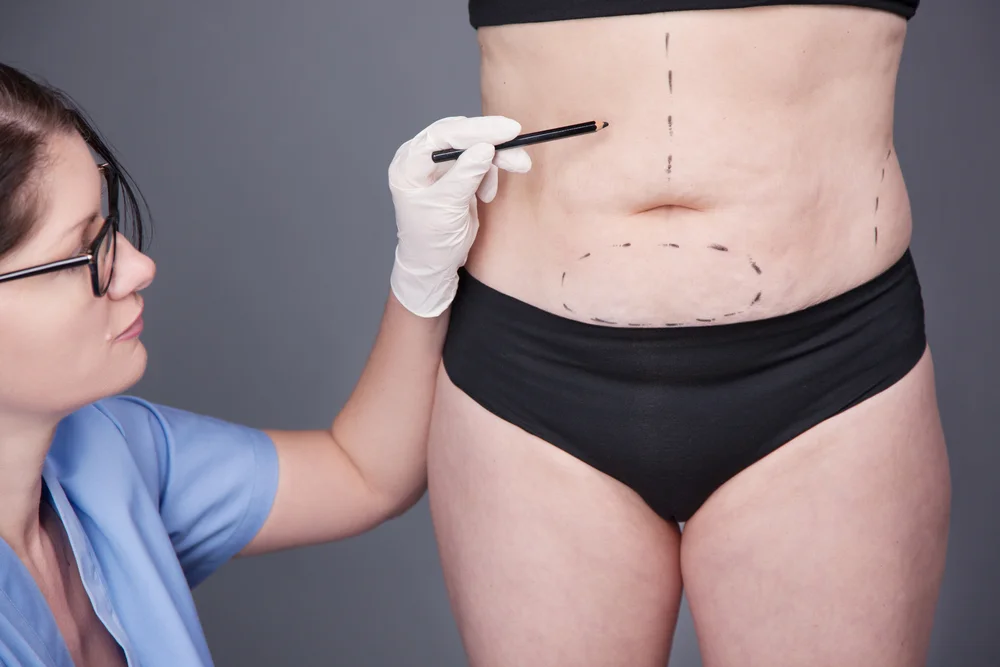- Tummy tuck surgery is not a permanent weight loss solution or a substitute for proper diet and exercise.
- Potential candidates with a BMI above 30 may need to lose weight before the procedure.
- A positive outcome is more likely in patients who maintain a healthy weight before and after surgery.
An abdominoplasty or tummy tuck entails the surgical removal of extra belly fat and skin while tightening or “tucking” the muscles of the abdominal wall.
A tummy tuck is not the same as liposuction, which removes fat under the skin by vacuum or suction. However, some patients may combine a tummy tuck with liposuction. Patients who maintain a healthy weight before and after the procedure see better results.
Read on to find out the long-term impact a sensible diet and lifestyle can have on your surgical outcome.
The Ins and Outs of Tummy Tucks
Many people consider tummy tucks when diet and exercise do not firm or flatten their bellies, which happens most frequently in cases of multiple pregnancies or following significant weight loss. A tummy tuck removes loose skin and stubborn fat around the belly that does not budge with diet and exercise.
There are three main types of tummy tuck surgery:
- A full abdominoplasty is performed by cutting the abdomen from hipbone to hipbone. The belly button is moved. The skin, tissue and muscle are contoured. Also, drainage tubes may be placed under the skin for a few days.
- Partial or mini-abdominoplasty usually lasts less than two hours, does not involve relocating the belly button, and is performed on patients who have fat deposits below the navel.
- Reverse tummy tuck involves an incision being made along the underside of the breasts, rather than near or below the belly button. As in the case of a traditional tummy tuck, excess skin and fat is removed and the remaining skin is redraped.
Not a Weight Loss Solution
Abdominoplasty does not replace diet and exercise as a way of losing abdominal fat. It is not a weight loss procedure. The surgery is intended to restructure and strengthen the muscle on the abdominal wall and remove a bit of leftover fat and skin.
It is ideally intended for people who are already close to their ideal stable weight, meaning they do not intend to lose more weight after the surgery and have been maintaining the same weight for several weeks.
Obesity Escalates Risk
With any major operation, being overweight confers certain risks that can stem both from the anesthesia and the procedure itself.
Dr. Constance Chen, a board-certified plastic surgeon at Mount Sinai in New York City, says, “If you are clinically obese, then you are at higher risk for wound healing complications and infections.” Dr. Chen notes that she makes sure to weigh all new potential candidates to gauge their potential surgical risks.
Estimating Body Fat Before Surgery
The Body Mass Index (BMI) is a quick, simple, inexpensive way to determine if people are underweight, overweight, obese or at a healthy weight for their height.
BMI can be used identify potential weight problems in individuals and is an easy way to screen candidates considering an abdominoplasty.
For adults 20 years and older, BMI is calculated using a formula that takes a person’s height and weight into account. It does not factor in age, sex, ethnicity, muscle mass or body proportions, so it may be less accurate than other methods of measuring body fat.
How BMI Is Calculated
The standard formula to calculate BMI is weight in kilograms divided by height in meters squared (kg/m2). There are many online tools available to help you compute BMI. Someone at a healthy weight typically has a BMI between 18.5 and 24.9. A BMI of 30 or greater is an indicator of obesity.
By itself, a BMI reading does not mean that a person immediately qualifies for a tummy tuck or is automatically ineligible. As every body is unique, your doctor will perform a more comprehensive exam and gather a detailed personal, medical and family history before determining if the procedure is right for you.
Screening for Risk
An abdominoplasty involves the use of some form of anesthesia – administered through a mask or an IV – to keep the patient unconscious and pain-free during the procedure.
Depending on the type of tummy tuck, the surgeon may recommend local anesthesia with oral sedation, conscious sedation or general anesthesia. Once the procedure is complete, reverse medications are administered to wake the patient up.
Surgical Risks
The American Society of Anesthesiologists warns that excess weight puts patients at risk for certain side effects and complications associated with administering or recovering from anesthesia.
Even if a person does not have conditions that are common in people with a BMI over 30, like diabetes or reflux, it can be difficult for doctors to safely:
- Place a breathing tube before the operation.
- Calculate the right dose of medications.
- Locate veins to deliver emergency medications intravenously.
- Ensure enough oxygen and airflow during the procedure.
In addition to the risks from anesthesia, Dr. Adam Schaffner, board certified plastic surgeon and Director of the Plastic Surgery Institute of New York, lists some of the potential complications from the actual procedure.
People with a BMI of 30 or higher have a significantly increased risk for:
- Blood loss during the procedure.
- Fluid collections in the abdomen.
- Blood clots in the legs (deep vein thrombosis).
- Blood clots in the lungs (pulmonary embolism).
- Post-operative pneumonia.
- Wound separation (where the edges no longer meet).
- Would healing problems (like dryness, ulcers, sensitivity, etc).
- Infections.
Major Weight Loss is Not the Goal
“There is no true ideal,” says Dr. Barry DiBernardo, a board-certified plastic surgeon and medical director of New Jersey Plastic Surgery. “The experienced surgeon evaluates the role of excess fat, loose skin, loose muscle wall and the degree of each one to come up with the best solution, which is not the same for everyone.”
If the patient has tried diet and exercise and needs another way to help with weight loss, then a tummy tuck is not the answer. In such cases, “bariatric surgery may be the best first step, like gastric band or bypass.”
Baseline BMI Heightens Tummy Tuck Risk
Another board certified plastic surgeon, Dr. John Corey in Scottsdale, Arizona says he’s “a bit of a stickler when it comes to BMI and a tummy tuck.” His cutoff is a BMI of 30.
Dr. Corey admits that he tries not to make exceptions to this rule, even if a prospective patient begs and pleads. On operating on patients with a BMI over 30, he explains that his reservations are because, “the rate of complications both big and small really climbs.”
His advice for all patients: “Get your lifestyle of diet, exercise and goal weight set first, and then use cosmetic surgery as a reward for hard work, not as a starting point. A candidate’s ideal weight should be very close to a weight they know they can maintain.”
Dr. Corey also advises against tummy tucks for patients who plan a significant weight loss right before or immediately after the surgery.
Set Realistic Expectations
As mentioned, an abdominoplasty is not a weight loss solution. It’s important that patients have realistic expectations of what a tummy tuck can and cannot do. For example, if there are stretch marks on the lower abdomen, a tummy tuck may remove them but they are not specifically targeted by the procedure.
Also, patients will have a scar that goes from hip bone to hip bone after a tummy tuck. The surgeon will try to make the incision in a less conspicuous place so the scar can be hidden by underwear or swimsuit bottoms.
Patients who have a tummy tuck need to take time off from work. The typical downtime is about two weeks, but can stretch up to six weeks without any heavy lifting. The specific risks and suitability of a tummy tuck for a given individual can be determined only at a consultation.
» If you would like to see if a tummy tuck is right for you, get consultations from our medical review team.









